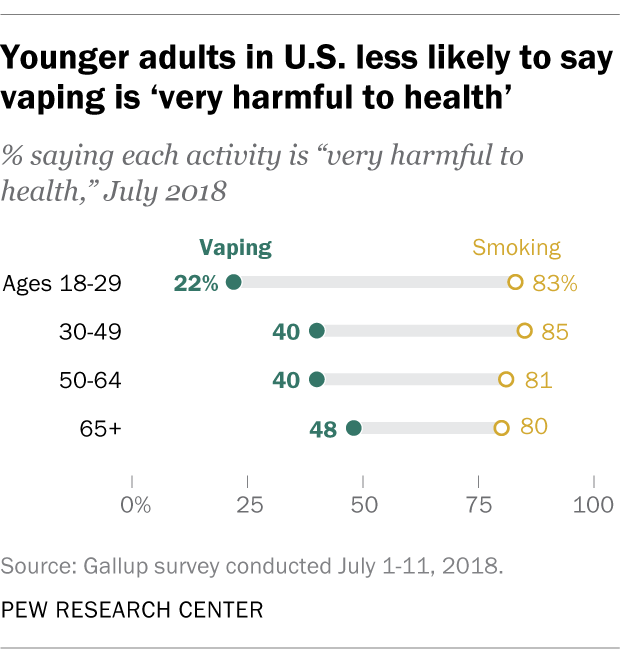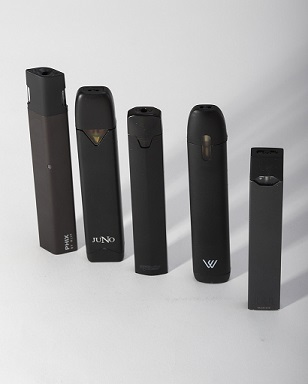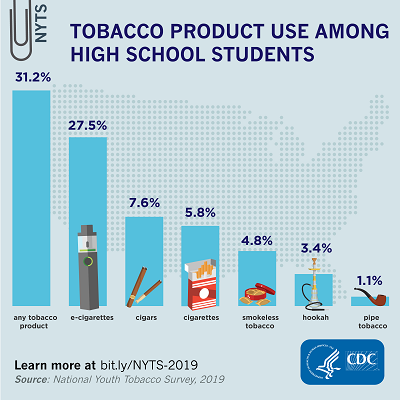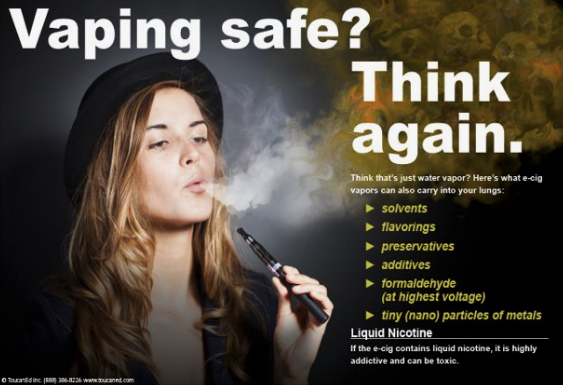Vaping Corner
E Cigarettes 101
What Are ENDS?
ENDS, or Electronic Nicotine Delivery Systems, encompass a wide range of noncombustible tobacco products. They may vary widely in design and appearance and go by a variety of names such as: “e-cigarettes,” “e-cigs,” “cigalikes,” “e-hookahs,” “mods,” “vape pens,” “vapes,” “tanks,” and “tank systems.” Despite the differing nomenclature, they generally operate in a comparable manner and are composed of similar components [1].
ENDS can be made to look like combustible cigarettes or other objects, including screwdrivers, lipstick, USBs, and pens [2]. Utilizing battery-powered atomizers, these devices deliver nicotine and other chemicals in vapor form to the user [2, 3]. Unlike combustible tobacco products where the tobacco is burned, ENDS contain cartridges filled with aerosolizing liquid, sometimes referred to as e-liquids, e-fluid, or e-juice. These liquids typically contain a humectant, like propylene glycol or vegetable which are the base of the liquid, nicotine, flavorings, and other additives1 that are heated into an aerosol and then inhaled [2].
USB Like ENDS
Youth and ENDS
A primary concern surrounding ENDS is youth targeted advertisements [1]. Research has found that most adolescents who report trying ENDS have never used traditional cigarettes [1]. There is concern that the variety of flavors available for ENDS attract youth, and studies show that ENDS use in youths can lead to tobacco use later in life[1]. Prevalence of ENDS use is highest in Hispanic and white males, especially young adults [2]. ENDS advertisements that target youth and young adults are especially problematic because nicotine is very addictive and can be harmful to brain development until the age of 25 [3].
According to the CDC, approximately 42% of students nationwide have tried an ENDS product, with about 3% having frequent use of such products.4 Because ENDS product use began to be recorded by the CDC in 2015, not much longitudinal data is available; however, there does not seem to be a statistically significant change in prevalence of ever trying or frequent use of ENDS by students nationwide from 2015 to 2017. [4]
Almost 14% of students who currently use ENDS products were able to buy these items in stores themselves [5]. The ease with which youths are able to buy ENDS in stores has been brought to the attention of concerned parents, educators, and public health officials – with the FDA Commissioner Scott Gottlieb, M.D. announcing “the largest single enforcement action in [FDA] history” in which it aims to cease the retail and online sales of e-cigarettes to minors.6 In the same press release, Commissioner Gottlieb also referred to the increase in prevalence of ENDS usage in youths as an “epidemic” as it has become “an almost ubiquitous… trend among teens.” [6]
USB-like ENDS:
A new type of ENDS that resembles a USB has become popular among youth and teens. JUUL was first company to develop USB-like ENDS, and other products, such as the MarkTen Elite and Pax Era, have followed [7]. The act of using a USB-like ENDS is sometimes referred to as JUULing [7].These devices come in a variety of flavors and are easy to disguise or hide [8]. Prior research on nicotine product use among adolescents suggests that ENDS usage in general could be potentially dangerous and addictive for the developing brains of youth and teenagers and can encourage adolescents to abuse nicotine [9].
USB-like ENDS are particularly concerning due to the fact that they are able to deliver high levels of nicotine, comparable to that of cigarettes, with fewer deterrents than other forms of tobacco products due to their use of nicotine salt solutions [10]. Traditional ENDS utilize free-base nicotine which can cause aversive user experiences, such as dizziness or nausea, if the nicotine concentration is high which does not occur with the nicotine salt solutions used in USB-like ENDS [10]. When compared to cigarettes, nicotine salts in USB-like ENDS are able to deliver similar levels of nicotine without the harsh taste that discourages some youths from continuing to smoke [10].
References:
- Amiri, A., & Vazquez, K. (2017). Electronic Nicotine Delivery Systems: Are You Prepared to Have a Conversation With Your Patients?. Alabama Nurse, 44(1), 14-16.
- Stratton, K., Kwan, L. Y., and Eaton, D. L. (2018). Summary. In Public Health Consequences of E-Cigarettes. Retrieved from https://www.nap.edu/read/24952/chapter/2(link is external)
- Center for Disease Control. E-Cigarettes Shaped Like USB Flash Drives: Information for Parents, Educators, and Health Care Providers. U.S. Department of Health and Human Services, Centers for Disease Control and Prevention
- Kann L, McManus T, Harris WA, et al. Youth Risk Behavior Surveillance - United States, 2017. MMWR Surveill Summ 2018;67(No. SS-8):1-114. DOI: http://dx.doi.org/10.15585/mmwr.ss6708a1(link is external)
- United States Department of Labor, Occupational Safety and Health Administration. (n.d.). Flavorings-Related Lung Disease, Diacetyl and 2, 3-Pentandione. Retrieved from https://www.osha.gov/SLTC/flavoringlung/diacetyl.html(link is external)
- United States Food and Drug Administration. (2018, September 12). Statement from FDA Commissioner Scott Gottlieb, M.D., on new steps to address epidemic of youth e-cigarette use [Press release]. Retrieved from https://www.fda.gov/NewsEvents/Newsroom/PressAnnouncements/ucm620185.htm(link is external)
- Kim SA, Smith S, Beauchamp C, Song Y, Chiang M, Giuseppetti A, et al. (2018) Cariogenic potential of sweet flavors in electronic-cigarette liquids. PLoS ONE 13(9): e0203717. https://doi(link is external). org/10.1371/journal.pone.0203717
- American Academy of Pediatricians Julius B. Richmond Center of Excellence. JUULing: What Pediatricians and Families Need to Know. Retrieved from: https://www.aap.org/en-us/Documents/AAP%20JUUL%20Factsheet.pdf(link is external)
- U.S. Department of Health and Human Services. E-Cigarette Use Among Youth and Young Adults: A Report of the Surgeon General-Executive Summary. Atlanta, GA: U.S. Department of Health and Human Services, Centers for Disease Control and Prevention, National Center for Chronic Disease Prevention and Health Promotion, Office on Smoking and Health, 2016.
- Barrington-Trimis, J. & Leventhal, A. (2018, August 22). Adolescents’ Use of “Pod Mod” E-Cigarettes – Urgent Concerns. The New England Journal of Medicine. 379, 1099 – 1102. DOI: 10.1056/NEJMp1805758.
Open configuration options
Youth & Vaping
E-cigarette Use in Youth Populations
In the U.S., Youth are more likely than adults to use e-cigarettes. In 2018 more than 3.6 million middle and high school students reported using e-cigarettes in the last 30 days.
Current (past 30 day) use of e-cigarettes went up among middle and high school students from 2011 to 2019. [1,2,3,4]
- About 1 of every 10 middle school students (10.5%) reported in 2019 that they used electronic cigarettes in the past 30 days—an increase from 0.6% in 2011.
- More than 1 of every 4 high school students (27.5%) reported in 2019 that they used electronic cigarettes in the past 30 days—an increase from 1.5% in 2011.
As many adults are using e-cigarettes to cut down their use of regular cigareets, only 1.3% of e-cigarette using adults report never bring a regular smoker, compared to the 40% of youth who report never being a regular cigarette smoker before using e-cigarettes.
What makes these products so popular among the youth?
Social and physical environments [5,6]
- The way mass media show tobacco product use as a normal activity can make young people want to try these products.
- Youth are more likely to use tobacco products if they see people their age using these products.
- High school athletes are more likely to use smokeless tobacco than those of the same age who are not athletes. [7, 5]
- Young people may be more likely to use tobacco products if a parent uses these products.
Biological and genetic factors [7,6,5]
- There is evidence that youth may be sensitive to nicotine and that teens can feel dependent on nicotine sooner than adults.
- Genetic factors may make quitting smoking harder for young people.
- A mother’s smoking during pregnancy may increase the likelihood that her children will become regular smokers.
Mental health [5]
- There is a strong relationship between youth smoking and depression, anxiety, and stress. [5]
- Personal views: When young people expect positive things from smoking, such as coping with stress better or losing weight, they are more likely to smoke.2,11
Other influences that affect youth tobacco use include: [5,8,9]
- Lower socioeconomic status, including lower income or education
- Not knowing how to say “no” to tobacco product use
- Lack of support or involvement from parents
- Accessibility, availability, and price of tobacco products
- Doing poorly in school
- Low self-image or self-esteem
- Seeing tobacco product advertising in stores, on television, the Internet, in movies, or in magazines and newspapers

Appeal of Flavors and Marketing for Youth Populations.
https://www.cdc.gov/tobacco/data_statistics/fact_sheets/youth_data/tobacco_use/index.htm
E-cigarettes can come in a variety of fruit, candy, cereal, soda, and other kid-friendly flavors that make these products more appealing compared to regular tobacco cigarettes. A majority of youth e-cigarette users report using flavored varieties, most youth e-cigarette users first start using e-cigarettes with a flavored variety, and flavors are the primary reason youth report using e-cigarettes.
E-cigarettes are also advertised using the same themes and tactics that have been shown to increase youth initiation of other tobacco products, including cigarettes. In 2016, about 8 in 10 middle school and high school students—more than 20 million youth—said they had seen e-cigarette advertising.
Widespread advertising for these products, including via media for which advertising for conventional tobacco products is prohibited (e.g., TV), and the lower costs of some of these products relative to conventional cigarettes has contributed to the increase in e-cigarette use among youth.
Not only are youth reporting initial e-cigarette out of curiosity of these new products and flavors, but because they believe these products to be less harmful compared to conventional tobacco cigarettes.

References
- Gentzke AS, Creamer M, Cullen KA, et al. Vital Signs: Tobacco Product Use Among Middle and High School Students—United States, 2011–2018. Morbidity and Mortality Weekly Report 2019;68:157–164.
- Cullen KA, Gentzke AS, Sawdey MD, et al. e-Cigarette Use Among Youth in the United States, 2019external icon. JAMA. Published online November 05, 2019.
- Wang TW, Gentzke AS, Creamer MR et al. Tobacco Product Use and Associated Factors Among Middle and High School Students—United States, 2019. Morbidity and Mortality Weekly Report, 2019;68(12) [accessed 2019 Dec 6].
- Centers for Disease Control and Prevention. Tobacco Product Use Among Middle and High School Students – United States, 2011 and 2012. Morbidity and Mortality Weekly Report, 2013;62(45):893-7 [accessed 2019 Feb 28].
- U.S. Department of Health and Human Services. Preventing Tobacco Use Among Youth and Young Adults: A Report of the Surgeon General. Atlanta: U.S. Department of Health and Human Services, Centers for Disease Control and Prevention, National Center for Chronic Disease Prevention and Health Promotion, Office on Smoking and Health, 2012 [accessed 2019 Feb 28].
- Centers for Disease Control and Prevention. E-Cigarette Use Among Youth and Young Adults: A Report of the Surgeon General. Atlanta: U.S. Department of Health and Human Services, Centers for Disease Control and Prevention, National Center for Chronic Disease Prevention and Health Promotion, Office on Smoking and Health, 2016 [accessed 2019 Feb 28].
- U.S. Department of Health and Human Services. The Health Consequences of Smoking—50 Years of Progress: A Report of the Surgeon General. Atlanta: U.S. Department of Health and Human Services, Centers for Disease Control and Prevention, National Center for Chronic Disease Prevention and Health Promotion, Office on Smoking and Health, 2014 [accessed 2019 Feb 28].
- U.S. Department of Health and Human Services. Reducing Tobacco Use: A Report of the Surgeon General. Atlanta: U.S. Department of Health and Human Services, Centers for Disease Control and Prevention, National Center for Chronic Disease Prevention and Health Promotion, Office on Smoking and Health, 2000 [accessed 2019 Feb 28].
- Centers for Disease Control and Prevention. E-Cigarette Use Among Youth and Young Adults: A Report of the Surgeon General. Atlanta: U.S. Department of Health and Human Services, Centers for Disease Control and Prevention, National Center for Chronic Disease Prevention and Health Promotion, Office on Smoking and Health, 2016 [accessed 2019 Feb 28].


